During the First World War and the subsequent years, Hella Moja (1892-1951) was one of the most popular stars of the German silent film era. There was even a Hella Moja series, and in 1918, the actress founded her own film company.
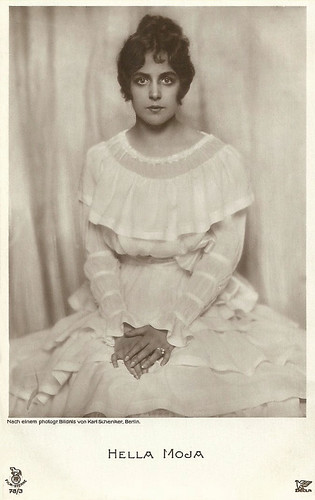
German postcard in the Film Sterne series by Rotophot, no. 78/3. Photo: Decla / Karl Schenker, Berlin.
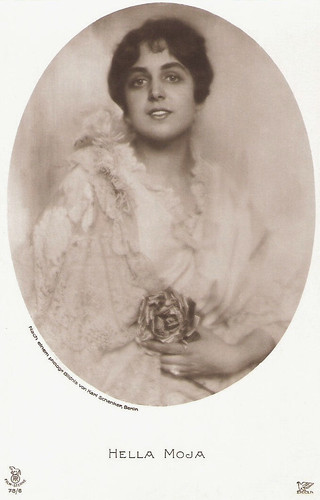
German postcard in the Film Sterne series by Rotophot, no. 78/6. Photo: Decla / Karl Schenker, Berlin.
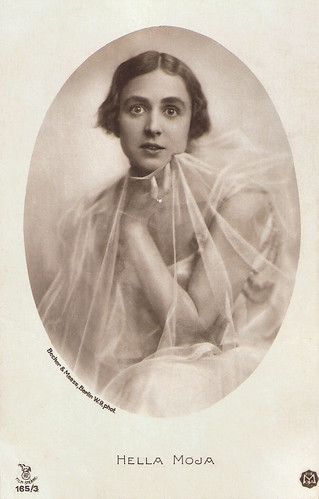
German postcard in the Film Sterne series by Rotophot, Berlin, no. 165/3. Photo: Becker & Maass, Berlin / Moja Film.
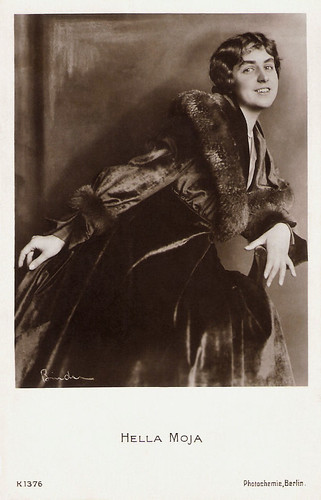
German postcard by Photochemie, Berlin, no. K. 1376. Photo: Alex Binder.
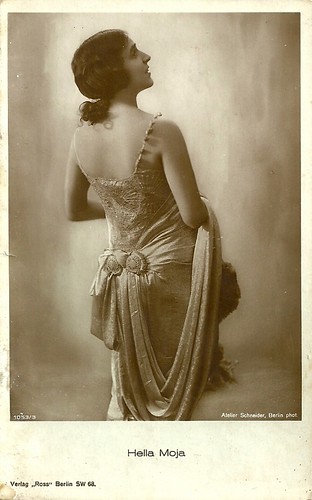
German postcard by Ross Verlag, no. 1053/3, 1927-1928. Photo: Atelier Schneider, Berlin.
According to IMDb, Hella Moja was born Helene Schwerdtfeger in Königsberg, Germany (now Kaliningrad, Russia) in 1896. However, the sources differ about her origins. Wikipedia writes that she was born as Helene Gertrud Mojzesczyck in Königsberg in 1892, and Thomas Staedeli at Cyranos writes that she was born either as Helene Morawski or as Helene Schwerdtfeger, in Ciemin-Zab, Russia, in 1892. Filmportal.de notes Helene Gertrud Schwerdtfeger as her birth name, Königsberg as her birthplace and 1892 as her birth year.

German postcard in the Film Sterne series by Rotophot, no. 78/3. Photo: Decla / Karl Schenker, Berlin.

German postcard in the Film Sterne series by Rotophot, no. 78/6. Photo: Decla / Karl Schenker, Berlin.

German postcard in the Film Sterne series by Rotophot, Berlin, no. 165/3. Photo: Becker & Maass, Berlin / Moja Film.

German postcard by Photochemie, Berlin, no. K. 1376. Photo: Alex Binder.

German postcard by Ross Verlag, no. 1053/3, 1927-1928. Photo: Atelier Schneider, Berlin.
Short silent melodramas
According to IMDb, Hella Moja was born Helene Schwerdtfeger in Königsberg, Germany (now Kaliningrad, Russia) in 1896. However, the sources differ about her origins. Wikipedia writes that she was born as Helene Gertrud Mojzesczyck in Königsberg in 1892, and Thomas Staedeli at Cyranos writes that she was born either as Helene Morawski or as Helene Schwerdtfeger, in Ciemin-Zab, Russia, in 1892. Filmportal.de notes Helene Gertrud Schwerdtfeger as her birth name, Königsberg as her birthplace and 1892 as her birth year.
Hella appeared early in her career at the Teatr Artystyczny in Warsaw. Then she went to Berlin and worked as a translator of Polish and Russian, and as a writer for the Deutsche Presse-Korrespondenz in Hannover, the Ullstein-Verlag and the Scherl-Verlag.
She followed acting classes with Emmanuel Reicher and Frieda Richard and debuted on the Berlin stage in 1913 at the Lessingtheater. She was spotted for the cinema by film star Alwin Neuss, who at the time worked as a director for the Decla-Film studio.
Hella Moja appeared in his silent film Der Weg der Tränen / The Way of the Tears (Alwin Neuss, 1916), based on a script by Ruth Goetz.
She also worked for pioneer studios like Messter, Union and Terra-Film, and excelled in short silent melodramas like Die weiße Rose / The White Rose (Franz Hofer, 1915) opposite Erna Morena, Der Schwur der Renate Rabenau / The Vow of Renate Rabenau (Otto Rippert, 1916), Der Fremde / The Stranger (Otto Rippert, 1917) with Werner Krauss and Das verwunschene Schloss / The Enchanted Castle (Otto Rippert, 1918) again with Krauss, often playing a countess or a damsel.
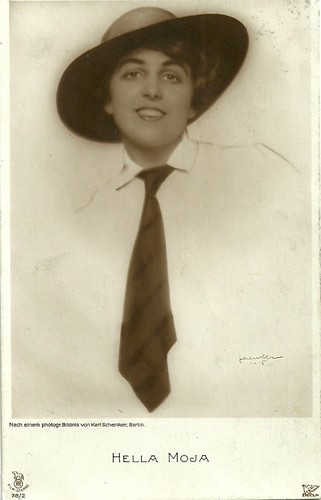
German postcard by Rotophot in the Film Sterne series, no. 78/2. Photo Karl Schenker, Berlin / Decla Film.
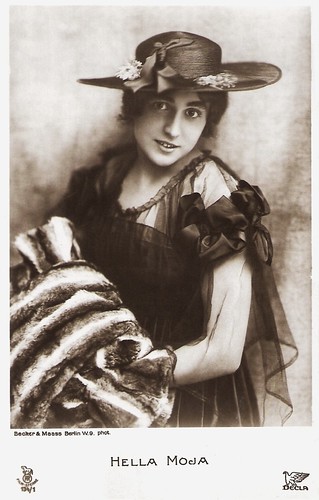
German postcard by Rotophot in the Film Sterne series, no. 134/1. Photo: Decla / Becker & Maass, Berlin.
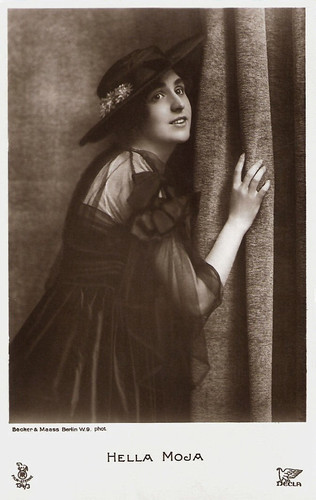
German postcard by Rotophot in the Film Sterne series, no. 134/3. Photo: Decla / Becker & Maass, Berlin.
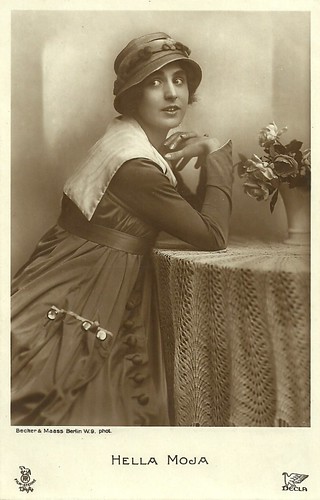
German postcard by Rotophot in the Film Sterne series, no. 134/4. Photo: Decla / Becker & Maass, Berlin.
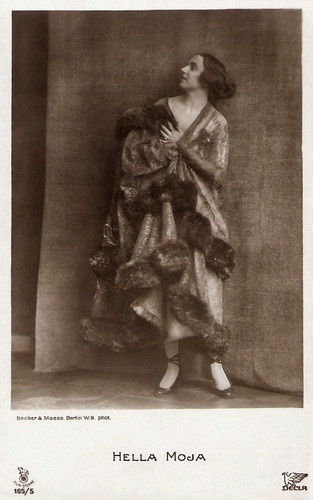
German postcard by Rotophot in the Film Sterne series, no. 165/5. Photo: Decla / Becker & Maass, Berlin.
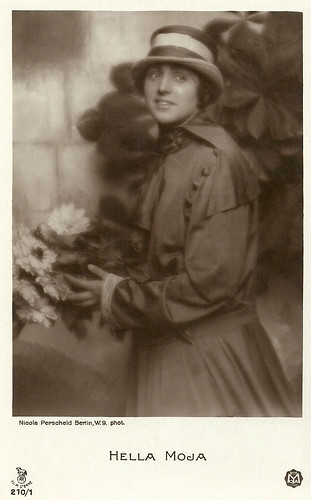
German postcard in the Film Sterne series by Rotophot, no. 210/1. Photo: Nicola Perscheid, Berlin / Hella Moja Film.
Theatrical acting style
In 1918, Hella Moja founded her own film company, the Hella Moja Filmgesellschaft, which would produce 16 films. Her first production was Wundersam ist das Märchen der Liebe / Wondrous is the Fairy Tale of Love (Leo Connard, 1918) with Ernst Hofmann, for which the critics especially praised her acting.
Another successful production was Die Augen von Jade / The Eyes of Jade (Iwa Raffay, 1918). In Figaros Hochzeit / The Marriage of Figaro (Max Mack, 1920), based on the play by Pierre Augustin Caron de Beaumarchais, she was again impressive as Cherubino, Figaro's page, opposite Alexander Moissi as Figaro.
Other films in which she appeared were Abgrund der Seele / The Abyss of Souls (Urban Gad, 1920), Gräfin Walewska/Countess Walewska (Otto Rippert, 1920) and Der Mann um Mitternacht / The Man at Midnight (Holger Madsen, 1924) with Olaf Fjord. From the mid-1920s on, her theatrical acting style in films like U 9 Weddigen / U Boat 9 (Heinz Paul, 1927) with Gerd Briese was deemed old-fashioned. Moja quit acting and focused on script writing.
During the Nazi period, she had additional problems because she could not prove to be Aryan. In 1934, she changed her name to Helka Moroff and co-wrote the script for Die Vier Musketiere / The Four Musketeers (Heinz Paul, 1934) starring Hans Brausewetter and Käthe Haack.
In 1938, she was expelled from the Reichsschrifttumskammer (RSK) with the excuse that she did odd jobs next to scriptwriting. From 1942 to 1951, the former silent film star worked as a prompter at the Stadttheater Kiel under the name Hella Sewa. In 1951, Hella Moja committed suicide. She had been married to Erich Morawsky and film director Heinz Paul.
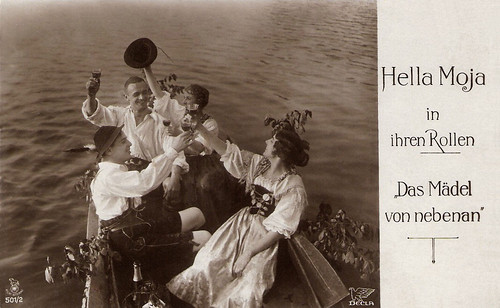
German postcard in the Film Sterne Series by Rotophot, no. 501/2. Photo: Decla. Publicity still for Das Mädel von nebenan / The Girl-next-door (Otto Rippert, 1917).
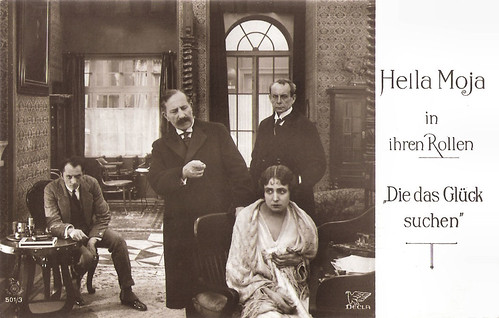
German postcard by Rotophot in the Film Sterne series, no. 501/3. Photo: Decla. Hella Moja and Theodor Loos (far left) in the German silent film Die das Glück suchen / Those Searching for Happiness (1917). Odd is that this title does not appear in the databases Filmportal.de and IMDb. By looking at the serial numbers of the Film Sterne series, the film must be from 1917.
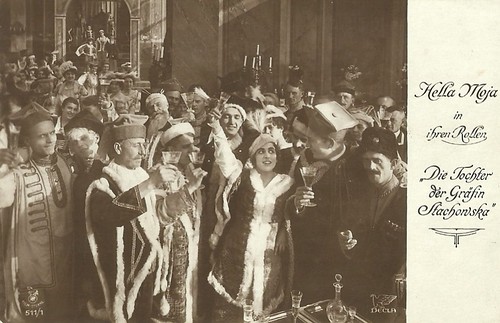
German postcard by Rotophot in the Film Sterne series, no. 511/1. Photo: Decla. Publicity still for Die Tochter der Gräfin Stachowska / The Daughter of Countess Stachowska (Otto Rippert, 1917).
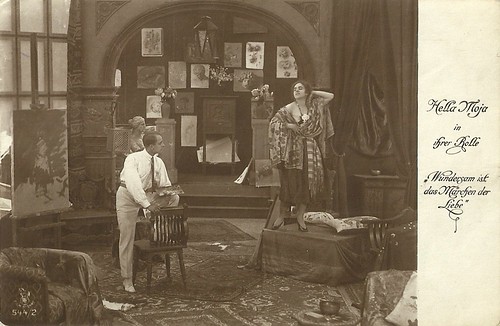
German postcard by Rotophot in the Film-Sterne series, no. 544/2. Photo: Hella Moja-Film GmbH Publicity still for Wundersam ist das Märchen der Liebe / Wonderful is the Fairy-Tale of Love (Leo Connard, 1918) with Hella Moja and Ernst Hofmann.
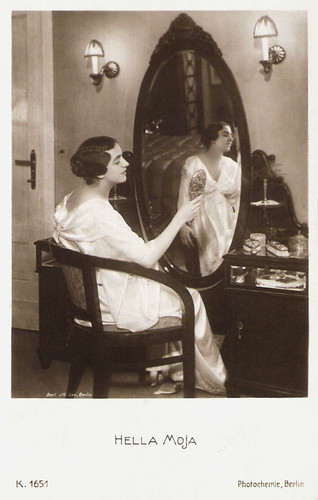
German postcard by Photochemie, Berlin, no. K 1651. Photo: Berliner Illustrations Gesellschaft.
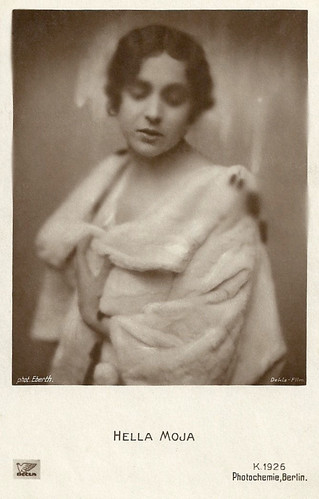
German postcard by Photochemie, Berlin, no. K 1926. Photo: Eberth / Decla-Film.
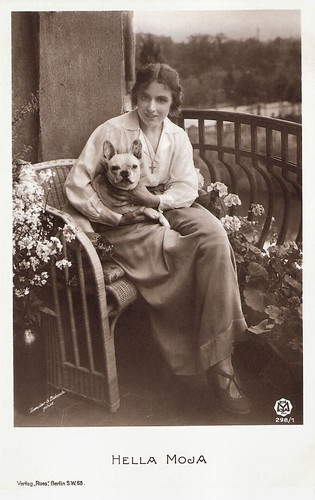
German postcard by Ross Verlag, no. 298/1, 1919-1924. Photo: Zander & Labisch / Hella Moja Film.
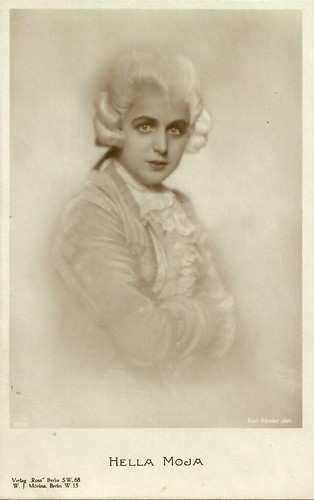
German postcard by Ross Verlag / W.J. Mörlins, Berlin, no. 320/1, 1919-1924. Photo: Karl Schenker, Berlin.
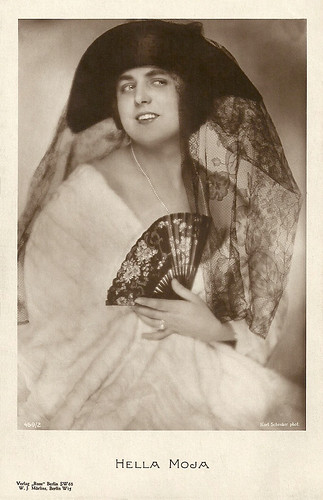
German postcard by Ross Verlag, no. 459/2, 1919-1924. Photo: Karl Schenker.
Sources: Filmportal, Thomas Staedeli (Cyranos), Deutsches Filminstitut (German), Wikipedia (German), BFI Film & TV Database, and IMDb.
This post was last updated on 9 October 2025.
No comments:
Post a Comment